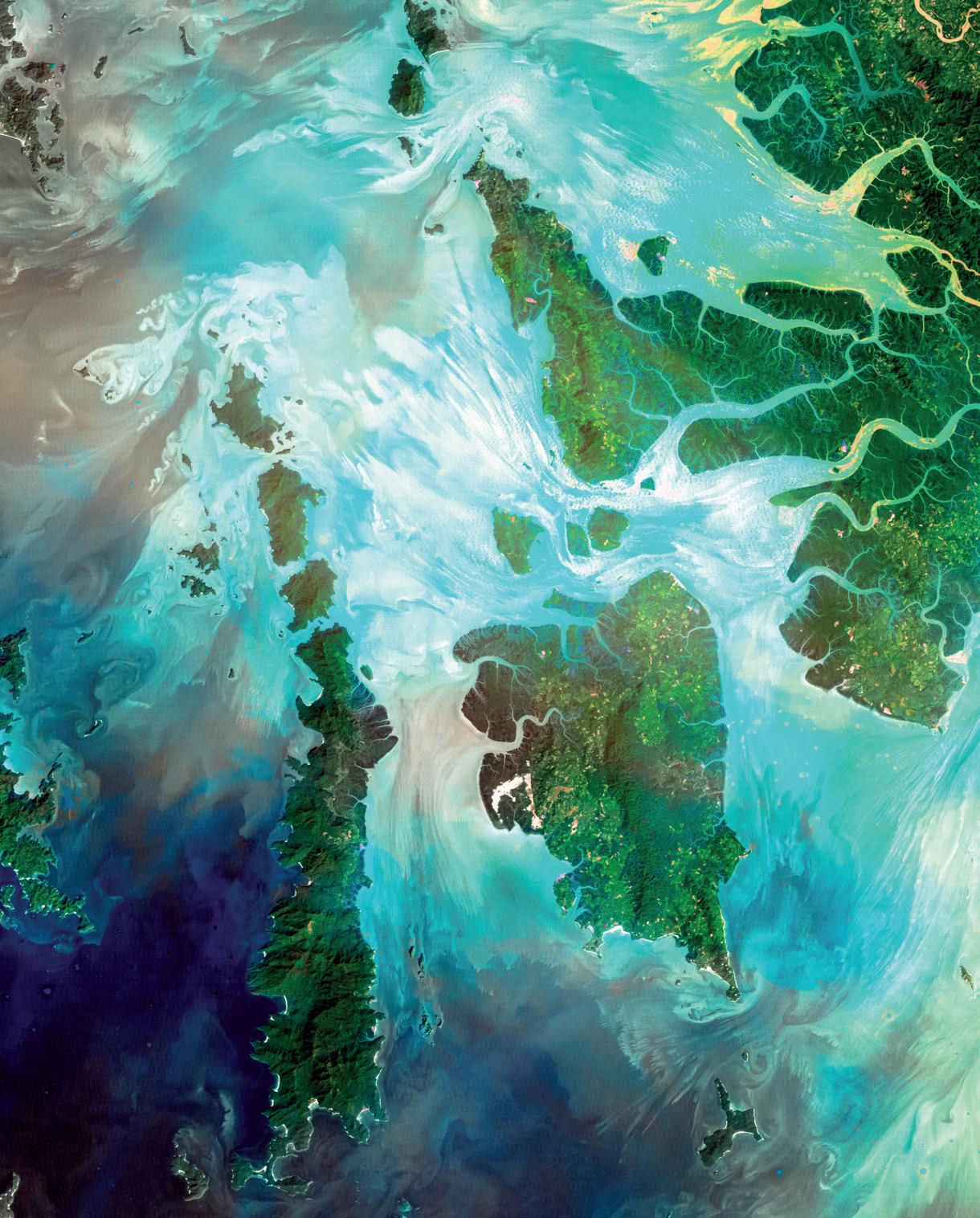
7 minute read
Ocean conservation and sustainable use

Healthy oceans and marine ecosystem services underpin the ocean economy, and provide critical support functions upon which human health and well-being depend. The multiple benefits that can be derived from healthy and resilient marine ecosystems are local, regional and global in scale, and range from coastal and habitat protection to climate mitigation and food provisioning. Coral ecosystems alone have been estimated to provide the world economy with an average annual value of USD 172 billion. This value is based on ecosystem services including food and raw materials, moderation of extreme ocean events, water purification, recreation, tourism, and maintenance of biodiversity.
Policy action is not keeping pace with pressures on the ocean
Enhanced action is needed to conserve and sustainably use our oceans and marine resources, which are under severe pressure from human activities, notably over-exploitation of fish and other marine resources, habitat destruction, invasive alien species, pollution and climate change (OECD, 2017a). Governments have a key role to play in putting in place an effective and coherent policy mix to ensure the achievement of SDG 14, to conserve and sustainably use our oceans, seas, and marine resources, and the relevant Targets of the Post-2020 Global Biodiversity Framework under the Convention on Biological Diversity. Relevant policy instruments include regulatory, economic, and information and voluntary approaches (Table 1). Despite recent progress, the pace of policy action is not keeping up with the pressures on oceans.
Marine protected areas (MPAs), one of the more traditional policy instruments for marine conservation and sustainable use, have been expanded in recent years and were one of the few Aichi Biodiversity Targets (under the CBD) and SDG 14 targets that were on track to be met by 2020. The extent to which they cover the full spectrum of marine life is still weak, however, and management effectiveness often poor (OECD, 2017a). MPAs must also be better integrated into emerging marine spatial planning instruments to increase effectiveness (OECD, 2017b), and complemented with a robust mix of other policy instruments to address the multiple pressures on the ocean. Marine Protected Areas: Economics, Management and Effective Policy Mixes (OECD 2017a) examines the evidence on the costs and benefits of MPAs and presents good practice insights on how to enhance the environmental and cost effectiveness of MPAs, and to scale up finance.
Table 1. A variety of policy instruments exist for marine conservation and sustainable use
Regulatory instruments (i.e. command-and-control) Economic instruments Information and voluntary approaches
Marine protected areas
Marine spatial planning and multiannual management plans Taxes, charges, user fees (e.g. entrance fees to marine parks)
Rights based management systems (e.g. individually transferable quotas for fisheries)
Spatial and temporal fishing closures; bans and standards on fishing gear; limits on number and size of vessels; other restrictions or prohibitions on use (e.g. CITES) Subsidies to promote biodiversity – and the reform of environmentally harmful subsidies
Catch limits or quotas (output controls) Payments for ecosystem services (PES)
Standards (e.g. MARPOL for ships); bans on dynamite fishing Biodiversity offsets
Licenses (e.g. aquaculture) Non-compliance penalties
Planning requirements (e.g. environmental impact assessments and strategic environmental assessments) Fines on damages Certification, eco-labelling
Voluntary agreements, including public-private partnerships (which can include, for example, voluntary biodiversity offset schemes)
Note: CITES: Convention on International Trade in Endangered Species; MARPOL: International Convention for the Prevention of Pollution from Ships (“marine pollution”). Source: Adapted from OECD (2017a), Marine Protected Areas: Economics, Management and Effective Policy Mixes.
Biodiversity can be mainstreamed through effective sectoral policies
Mainstreaming marine conservation and sustainable use across all sectors of the ocean economy is vital to ensuring the sustainability of the ocean economy. This is best brought about through better understanding of the benefits provided by ocean and marine ecosystems, including their values. Marine ecosystems considerations must then be mainstreamed in national development strategies, marine spatial planning policies and fisheries plans, among others. Effective policies must be put in place to ensure externalities are addressed, and that robust monitoring and evaluation of mainstreaming occurs over time. Mainstreaming Biodiversity for Sustainable Development (OECD, 2018a) draws on experiences and insights from 16 predominantly megadiverse countries to examine how biodiversity is being mainstreamed at the national level in agriculture, forestry and fisheries sectors and in development co-operation. It also considers the monitoring and evaluation of biodiversity mainstreaming and how this could be improved. Key messages from the report include the need to establish a strong social and business case for biodiversity; to develop monitoring and evaluation systems for mainstreaming; and to align policies across biodiversity and the different sectors.
Overcome and avoid political obstacles to policy reform
Political economy issues such as competitiveness concerns, distributional implications and vested interests can act as a brake on policy reform. This makes the study of barriers to effective marine policy reform and how they might be overcome vital. The Political Economy of Biodiversity Policy Reform (OECD, 2017c) provides insights on the types of obstacles that have been encountered in designing and implementing effective marine and terrestrial biodiversity policy reform. Drawing on recent examples of relevant policy reforms in a number of countries, the publication provides key messages on how these obstacles can be overcome, including building alliances between economic
and environmental interests, devising targeted measures to address potential impacts on competitiveness and income distribution, and building a robust evidence base to support reform and provide resistance to pressure from vested interests.
Recent OECD work has also examined ocean-relevant economic instruments that governments have put in place, covering taxes, fees and charges, subsidies, and tradable permit schemes. The information is derived from the OECD Policy Instruments for the Environment (PINE) database, to which more than 120 countries currently contribute (Figure 3). This enables to identify policy instruments that are relevant to SDG 14 (Conserve and sustainably use the oceans, seas and marine resources). While most of these policy instruments are relevant to the conservation and sustainable use of biodiversity (covering both terrestrial and marine ecosystems), there is not 100% overlap in those instruments tagged as (marine) biodiversity-relevant and those tagged as ocean-relevant, as in some cases, there may also be trade-offs involved in achieving different environmental objectives. Evaluate and improve marine biodiversity policies
While scaling up policy instruments for ocean conservation and sustainable use is crucial in order to achieve SDG 14 and related goals and targets under the CBD, further effort is also needed to evaluate the effectiveness of existing policy instruments, and how they can be improved. A recent inventory of rigorous impact evaluation studies identifies 80 studies that examine how biodiversity policies have fared. However, less than a handful of these focussed on marine biodiversity as opposed to terrestrial biodiversity issues (Karousakis, 2018). A key message from the report is that governments could endeavour to develop a strategic approach to scale up impact evaluation (and cost-effectiveness analysis) studies so as to build a stronger evidence base for more environmentally- and costeffective biodiversity policy instruments. This could include considerations of geographic representability, ensuring a good balance between different policy instruments and terrestrial and ocean/marine ecosystems, and ideally prioritising larger initiatives.
Figure 3. There is untapped potential to expand economic policy instruments for ocean conservation and its
sustainable use

Note: Based on 124 countries reporting to the database. Multiple tags per instrument are possible, so instruments can be included more than once. Only active instruments are shown; discontinued instruments are excluded. Source: OECD Policy Instruments for the Environment (PINE) database, https://pinedatabase.oecd.org, accessed on 5 May 2022.
KEY PUBLICATIONS OECD (2021), “Biodiversity, natural capital and the economy: A policy guide for finance, economic and environment ministers”, OECD Environment Policy Papers, No. 26, OECD Publishing, Paris, https://doi.org/10.1787/1a1ae114-en.
OECD (2021), “Tracking Economic Instruments and Finance for Biodiversity”, https://www.oecd.org/environment/resources/ biodiversity/tracking-economic-instruments-and-finance-for-biodiversity-2021.pdf
OECD (2020), Environment at a Glance 2020, OECD Publishing, Paris, https://doi.org/10.1787/4ea7d35f-en.

OECD (2019), Biodiversity: Finance and the Economic and Business Case for Action, OECD Publishing, Paris, https://doi.org/10.1787/a3147942-en.
Karousakis, K. (2018), “Evaluating the effectiveness of policy instruments for biodiversity: Impact evaluation, cost-effectiveness analysis and other approaches”, OECD Environment Working Papers, No. 141, OECD Publishing, Paris, https://doi.org/10.1787/ff87fd8d-en.
OECD (2018a), Mainstreaming Biodiversity for Sustainable Development, OECD Publishing, Paris, https://doi.org/10.1787/9789264303201-en.
OECD (2017a), Marine Protected Areas: Economics, Management and Effective Policy Mixes, OECD Publishing, Paris, https://doi.org/10.1787/9789264276208-en.
OECD (2017b), “Marine Spatial Planning: Assessing net benefits and improving effectiveness”, Green Growth and Sustainable Development Issue Paper, OECD Publishing, Paris. https://oe.cd/ggsd2017msp.
OECD (2017c), The Political Economy of Biodiversity Policy Reform, OECD Publishing Paris, https://doi.org/10.1787/9789264269545-en
KEY WEBSITES http://oe.cd/biodiversity http://oe.cd/post-2020-biodiversity-workshop
CONTACT Katia Karousakis – Katia.Karousakis@oecd.org







